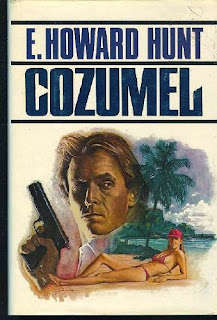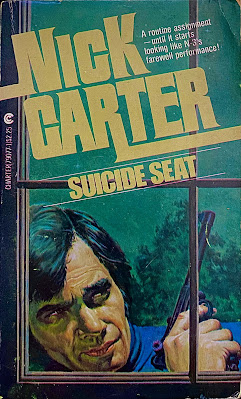Fisher was born on August 29th, 1912 in Marine City, Michigan. At some point his family relocated to Los Angeles so his mother could pursue an acting career. Fisher was enrolled into Oneonta Military Academy. It was there that he apparently sold a story to a small magazine as a teenager. But, he had enough of school and his personal life and ran away at age 16. He would later join the U.S. Navy and was stationed in Honolulu, Hawaii.
Fisher's writing career took off with two articles that he wrote for the Navy's magazines – Our Navy and U.S. Navy. When he was discharged in 1932, Fisher returned to Los Angeles to continue writing for U.S. Navy. His work was so closely aligned with the Navy that they officially advertised Fisher as “The Navy's Foremost Writer”.
Outside of the Navy publication, Fisher also started writing original short erotic fiction stories, which was published in 1933 and 1934 in magazine format. Sometime in the late 20s or early 30s, Fisher became married. In 1933, he moved to Greenwich Village in New York and lived close to the offices of Street and Smith, the dominant pulp publisher at that time. Friends and contemporaries stated that Fisher had a rough time as a New Yorker and was evicted several times. It became known that he even pawned his typewriter and used rejected manuscripts at lunch wagons promising that someday he would make it.
Author Frank Gruber moved to New York around the same time so the two of them became lifelong close friends. The friendship pushed Fisher in the right direction. Later, the two became friends with Cornell Woolrich. In 1934, Fisher's first non-erotic or romance story was published. It was a nautical story called “Authorized Mutiny” and it was published in the February 1934 issue of Top Notch. Some resources show his first non-erotic story was “Hell’s Scoop” and it was included in the March 1934 issue of Sure-Fire Detective Magazine. In 1935, lowly publisher Phoenix Press published his romance novel Spend the Night. They also bought and published two more of his novels - Satan's Angel and Forever Glory.
By 1936 Fisher had become divorced. He then married a Popular Publications Inc. editor named Edythe Syme. By 1937, Fisher was really hitting his stride and providing stories regularly for Black Mask. In 1938, Fisher also refined his romance stories and sold them to the slick magazines like Empire, Cosmopolitan, and Liberty.
Fisher's pulp career is often highlighted by the characters he created and wrote about. I've highlighted some of the prominent characters:
Captain Baby Face – This character's name is Jed Garrett but he's known as Captain Babyface and he works for the American Special Agent's Corps. His mission in the series is to kill Mr. Death, an evil genius working for Germany. There were ten total stories and they ran January through November of 1936 in the Dare-Devil Aces pulp magazine. The publisher Age of Aces has all ten stories combined into one awesome, 230-page volume and you can obtain it through Amazon HERE.
Sheridan Doome - Doome is a Lieutenant Commander and chief detective for U.S. Naval Intelligence. His job is to investigate crimes committed on Naval bases and ships. Doome flies a special black airplane and his face is monstrously disfigured from a WW1 explosion. These stories appeared in the back pages of The Shadow Magazine beginning on May 1st of 1935. There were six Sheridan Doome stories in The Shadow Magazine in 1935. These six were the only Sheridan Doome stories published under Steve Fisher's real name. Beginning in 1937, they were all written under the pseudonym Stephen Gould. In the pulp magazine The Shadow, there were 54 total Sheridan Doome stories between 1935 and 1943. Fisher also placed Sheridan Doome in two full length novels - 1936's Murder of the Admiral and 1937's Murder of the Pigboat Skipper.
Big Red Brennan – This character is a U.S. Naval Intelligence agent fighting enemy spies in the U.S. and in Shanghai. Accoring to Spy Guys and Gals, who gather information from The Encyclopedia of Pulp Heroes by Jeff Nevins, Big Red Brennan's adversary is a former American Naval Lieutenant who sold out to a spy ring of Chinese and Mongolians. There are 24 Big Red Brennan stories and they ran from October 1936 through December 1937 in a pulp magazine called The Feds. The rest of the series was in the magazine Crime Busters and that ran from February 1938 through May 1939.
Danny Garrett – Garrett is a 13-year old shoe shine boy in New York City that solves crimes and catches criminals. His nickmane is Shoeshine Kid Detective. There were 65 of these stories from 1936 through 1946. Nearly all of these are in The Shadow. Two were in Crack Detective Stories and one in Mammoth Detective. There were even more Danny Garrett stories during that time written by both William G. Bogart and Fisher under the house pseudonym Grant Lane. The character was so popular that it spawned 18 appearances in comic book form beginning with Doc Savage Comics #1 in 1940.
Tony Key – This character appeared in 12 stories in Detective Fiction Weekly and Black Mask from 1937 to 1941, beginning with “Murder Game–With Mirrors” in Detective Fiction Weekly, May 15, 1937. Key works in Hollywood and poses as a film and television agent. But, his real job is a detective for the film studios. He solves crimes involving producers, actors, and writers. He's described as always wearing flannels, white shoes, a white sweater, and a black coat. He has “patent leather hair.” His secretary and lover is the smart, pretty platinum blonde Betty Gale, and his ally is Mickey Ryan on the Homicide Squad. You can purchase the Tony Key stories in a collection from Black Mask HERE.
Mark Turner – Turner works as captain of the detectives in Honolulu, HI. He’s described as having red hair and a red Vandyke styled beard. Because of his brown eyes offset by red hair, the natives call him Red Eyes. Turner appeared in five stories. They were published in The Mysterious Wu Fang, Mystery Adventure Magazine, and Ten Detective Aces from 1935 to 1937.
Johnny Connel – Perhaps the shortest lived character, Connel only appears in two stories. The first was “Murder Melody” and it was in Detective Tales June 1941. That same character is in “Blues for a Dead Lady”, which was in Detective Tales March 1951. I couldn't locate any information about this character.
Fisher wrote about 500 stories for the magazines and pulps but he also wrote a number of full-length novels. His most popular book is probably the 1941 novel I Wake Up Screaming. It's about a promoter who is a suspect in the murder of a starlet. The book was compared to Cornell Woolrich, which makes sense considering Fisher and Woolrich were friends. He even has a character in the book named Cornell as a tribute to his friend. The book became a hit film the same year and kick-started the crime-noir film era. It was even filmed again in 1953 under the same title. With I Woke Up Screaming, Fisher really made a statement that he had moved on from the pulps.
Fisher authored 16 total full-length novels including No House Limit in 1958, which was later reprinted by Hard Case Crime.
Fisher moved to Hollywood, CA and began a long-running, highly successful career writing and producing films and television shows. He was nominated for an Academy Award in 1944 for his screenplay Destination Tokyo, which was adapted from his novel. He wrote and produced seemingly hundreds of shows and films up until his death on March 27th, 1980 in Canoga Park, CA.



































